Contents
Home-brewed beer compares favorably with cheap store-bought counterparts with a richer taste, thick foam and the absence of preservatives. It turns out a drink that does not contain anything superfluous. I will show you how to brew beer according to the classic recipe using only traditional ingredients: hops, malt, water and yeast. To preserve the original taste, we will not resort to filtration and pasteurization.
It is believed that to make real beer you need to buy a mini brewery or other expensive equipment. This myth is imposed by manufacturers of such products. Together with the brewery, such offices will gladly sell a ready-made concentrate, which only needs to be diluted in water and fermented. As a result, a novice brewer pays exorbitant prices for beer, the quality of which, at best, is slightly higher than cheap store brands.
In fact, you can make homemade beer without special equipment, using the available tools: a large cooking pot, a fermentation tank made of plastic or glass, any bottles and other available devices, the full list of which is published below.
You will have to buy only hops, malt and brewer’s yeast. I do not insist on choosing a particular company or brand. The range is wide enough, buy any product you like.
Theoretically, malt and hops can be grown at home. But these processes are beyond the scope of the article. Further, we will assume that all the necessary ingredients are available: homemade or purchased. The only thing is that I do not advise you to experiment with brewer’s yeast, but immediately choose the best strains in the store, since beer differs from grain mash precisely in special yeast.
Ingredients:
- water – 27 liters;
- hops (alpha acidity 4,5%) – 45 grams;
- barley malt – 4 kg;
- brewer’s yeast – 25 grams;
- sugar – 8 grams per liter of beer (needed for natural saturation with carbon dioxide).
Necessary equipment:
- 30-liter enamel pot – for boiling the wort;
- fermentation tank – for fermentation;
- thermometer (required) – if moonshine from sugar or wine can be made only by approximately controlling the temperature, then with beer this is an initially failed undertaking;
- bottles for pouring finished beer (plastic or glass);
- silicone hose of small diameter – for removing beer from the sediment;
- ice water bath or wort cooler;
- gauze (3-5 meters) or a bag of cloth;
- iodine and a white plate (optional);
- hydrometer (optional) – a device for determining the sugar content of the wort.
Brewing home beer
1. Preparation
The first stage, during which the brewer checks the availability of the right ingredients and the readiness of the equipment for work. I also advise you to pay attention to the following points.
Sterilization. Wash all used containers and accessories well with hot water and dry. Before working with the ingredients, the brewer thoroughly washes with soap and dries his hands dry. It is very important not to infect beer wort with wild yeasts and pathogens, otherwise you will get mash instead of beer. Neglect of sterilization eliminates all further efforts.
Water. It is better to use spring or bottled water. In extreme cases, ordinary tap water is also suitable. Before brewing beer, tap water is defended for a day in open containers. This time is enough for the chlorine to evaporate, and heavy metals and salts to settle at the bottom. Subsequently, the settled water is carefully drained from the sediment into another container through a thin tube.
Yeast. For normal fermentation, 15-30 minutes before adding to the wort, brewer’s yeast is activated with a small amount of warm water (temperature not higher than 28 degrees). There is no universal method that allows you to properly dilute any brewer’s yeast. Therefore, you must follow the instructions on the package.
2. Mashing of wort
This term refers to the mixing of crushed malt with hot water to break down the starch in the grains into sugar (maltose) and solubles (dextrins). Sometimes the malt is sold ready for brewing, crushed, which makes things a little easier. If not, the dried sprouted grain must be ground on its own using a grain crusher or a mechanical meat grinder.
Attention! Grinding does not mean grinding into flour, you just need to grind the grains into small pieces, be sure to save particles of the grain peel, which will then be required to filter the wort. The correct grinding option is shown in the photo.
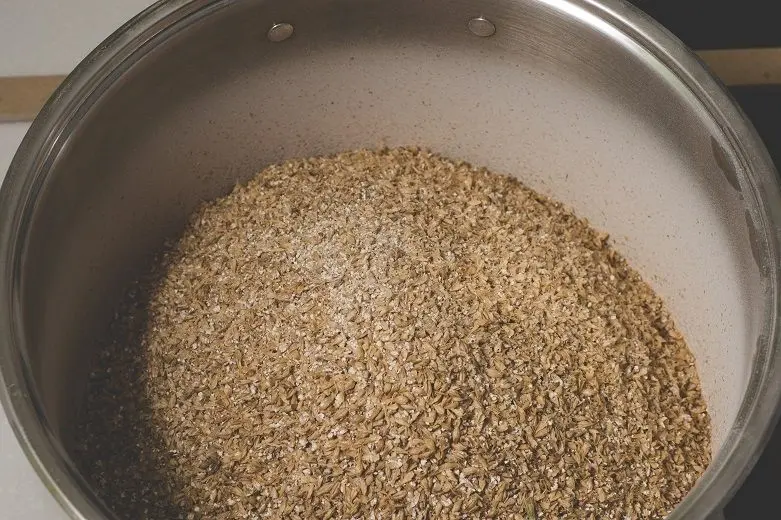
25 liters of water are poured into an enamel pan and heated on the stove to 80 ° C. Next, the ground malt is poured into a fabric or home-made bag measuring 1 by 1 meter, made from 3-4 layers of gauze. A bag of malt is immersed in water, the pan is covered with a lid and boiled for 90 minutes, maintaining a stable temperature of 61-72 ° C.
Malt grouting at 61-63 degrees promotes a better yield of sugars, increasing the strength of home-brewed beer. At 68-72 °C, the density of the wort increases, although the alcohol content in the drink will be slightly lower, but the taste will be richer. I recommend sticking to the temperature range of 65-72°C, which results in a tasty dense beer with a strength of 4%.
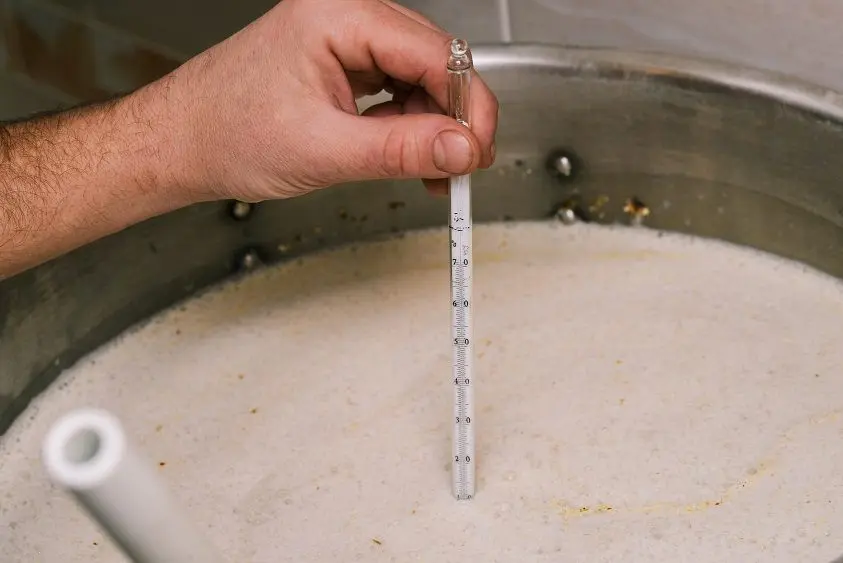
After 90 minutes of boiling, an iodine test is done to make sure that there is no starch left in the wort. To do this, 5-10 milligrams of the wort is poured onto a clean white plate and mixed with a few drops of iodine. If the solution has turned dark blue, you need to cook the contents of the pan for another 15 minutes. If the iodine hasn’t changed the color of the wort, you’re done. You can not do an iodine test, but simply increase the mashing (brewing) time by 15 minutes, the quality of the drink will not suffer from this.
Then the temperature is raised sharply to 78-80 ° C and the wort is boiled for 5 minutes to completely stop the work of the enzymes. Next, the bag with malt residues is removed from the container and washed with 2 liters of boiled water at a temperature of 78 degrees. So the residues of extractive substances are washed out. Wash water is added to the wort.
This method of mashing is called “in a bag” and allows you to do without filtration – the separation of grains (undissolved malt particles) from the main wort. In turn, filtration requires specific equipment (cleaning systems) and reusable transfusion of wort from one container to another. Mashing in a bag does not affect the quality of the brewed beer in any way, but takes much less time.

3. Boiling the wort
The contents of the pan are brought to a boil and the first portion of hops is added, in our case it is 15 grams. After 30 minutes of intense boiling, the next 15 grams are added, and after 40 minutes the remaining 15 grams of hops are boiled for another 20 minutes.
Depending on the chosen beer recipe, the time intervals and the amount of hops may vary. But, adhering to the indicated sequence and proportions, you are guaranteed to get a normal result.
Boiling takes an hour and a half, during all this time it is important to maintain intense heating so that the wort gurgles.
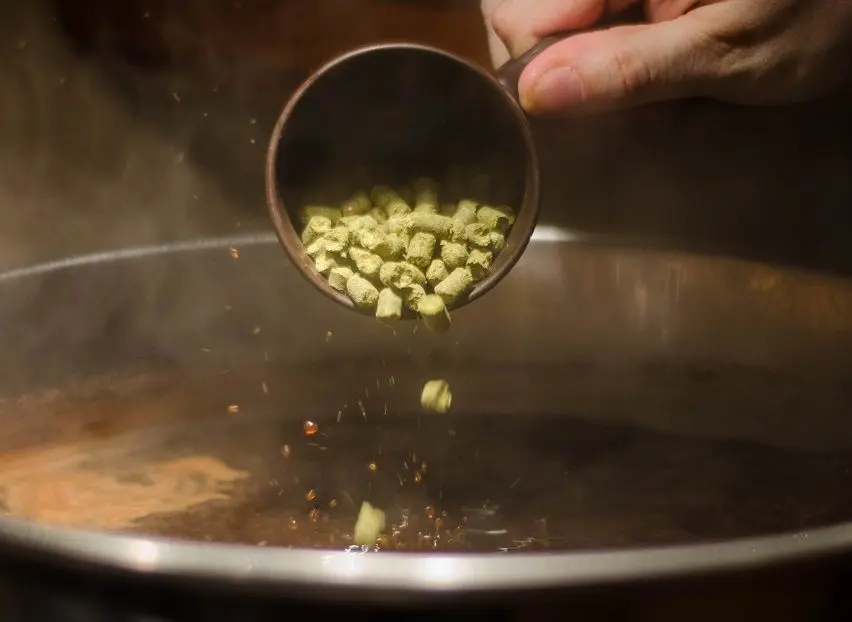
4. Cooling
Beer wort needs to be cooled quickly (in 15-30 minutes) to 24-26°C. The sooner this is done, the less risk there is of contaminating the drink with fermentation-damaging bacteria and wild yeasts.
You can cool the wort with a special immersion cooler (one of the possible designs in the photo) or carefully transfer the container to a bath of ice water. Most beginner brewers use the second method. The main thing is not to accidentally turn over a hot pan, scalding yourself with boiling water.
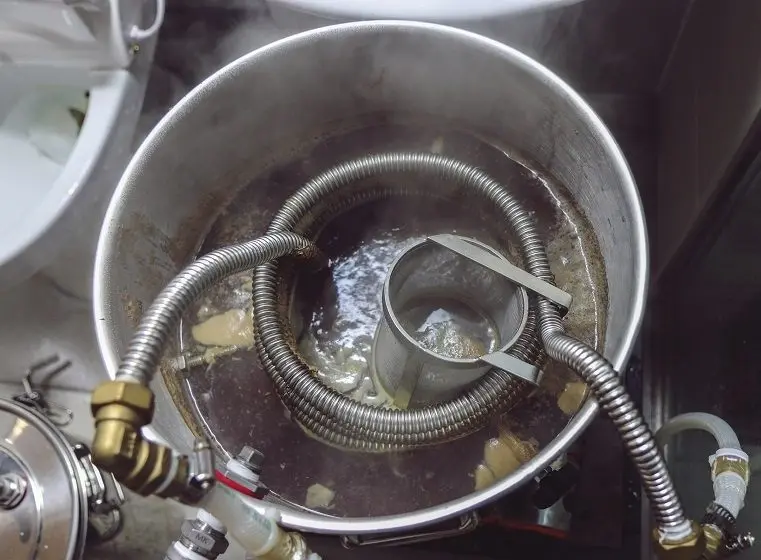
The cooled wort is poured through cheesecloth into a fermentation tank.
5. Fermentation
Diluted brewer’s yeast is added to the wort and mixed well. In this case, it is very important to observe the temperature and proportions indicated in the instructions on the sachet label.
There are top-fermenting yeasts, which are fermented at a temperature of 18-22°C, and bottom-fermenting, working at 5-16°C. These two types make different beers.
The filled fermentation container is transferred to a dark place with a temperature recommended by the yeast manufacturer. In our case it is 24-25°C. Then a water seal is installed and left alone for 7-10 days.
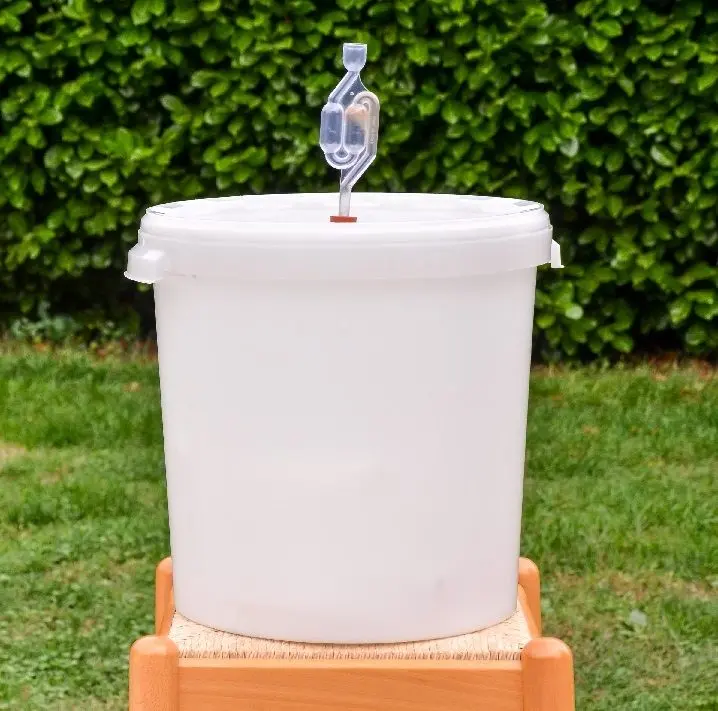
After 6-12 hours, active fermentation will begin, which usually lasts 2-3 days. At this time, the water seal actively bubbles, then the frequency of carbon dioxide release slowly decreases. At the end of fermentation, young homemade beer becomes light. Readiness is determined by two methods: a saccharometer (hydrometer) and a water seal.
In the first case, the readings of two hydrometer samples for the last 12 hours are compared. If the values differ slightly (by hundredths), then you can proceed to the next step. Not everyone has a sugar meter, so at home they often just look at the water seal. The absence of bubbles within 18-24 hours indicates the end of fermentation.
6. Plugging and carbonation
Carbonization of beer is the saturation of the drink with carbon dioxide, which contributes to the improvement of taste and the appearance of thick foam. Despite the complicated name, the process itself is very simple.
Sugar is added to beer storage bottles (preferably dark ones) at the rate of 8 grams per 1 liter. The sugar will cause a slight secondary fermentation, which will saturate the beer with carbon dioxide. Then the beer is drained from the sediment through a silicone tube, filling the prepared bottles.
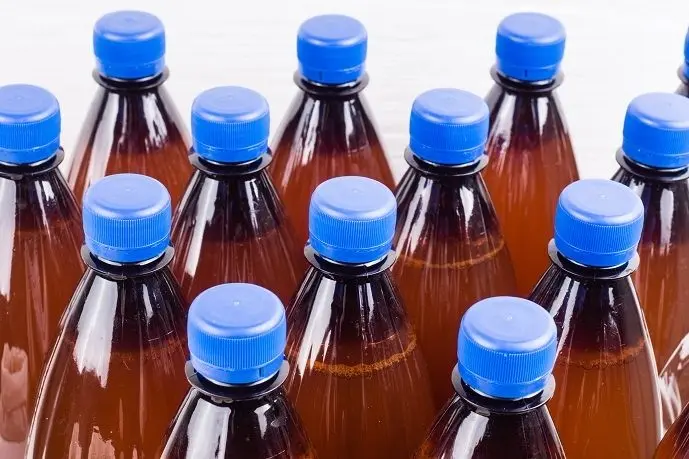
One end of the tube is lowered to the middle of the container with beer, the other – to the very bottom of the bottle, this minimizes the contact of the drink with air. It is important not to touch the yeast, which, depending on the type, can settle to the bottom or accumulate on the surface, otherwise the beer will turn cloudy. The bottles are not topped up 2 cm to the neck and tightly corked.
The easiest way is to use a plastic container, since the lids for it can be twisted by hand. For glass bottles, you need yoke corks or a special device for corking ordinary beer corks (pictured).

The bottles filled with beer are transferred to a dark place with a temperature of 20-24°C and left for 15-20 days. Once every 7 days, the containers must be shaken well. After that, the drink is placed in the refrigerator.
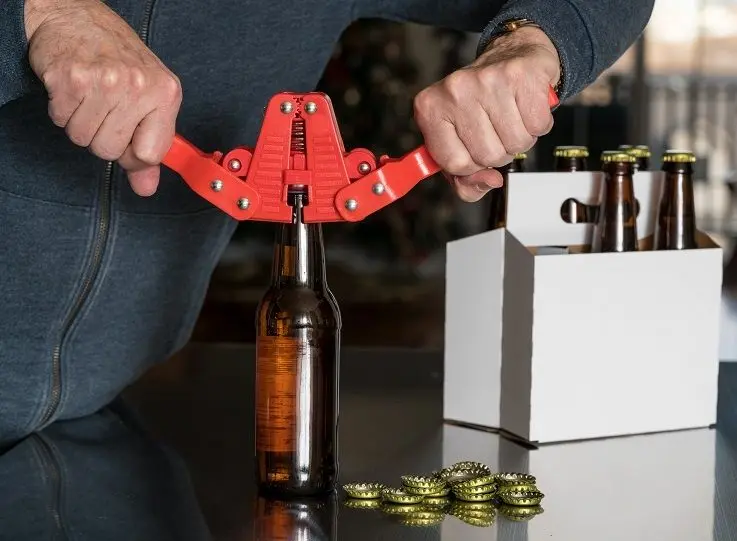
7. Maturation
Homemade beer is ready. But if you let the drink stand for another 30 days, the taste will improve significantly.
Beer can be stored in the refrigerator for 6-8 months, an open bottle – 2-3 days.
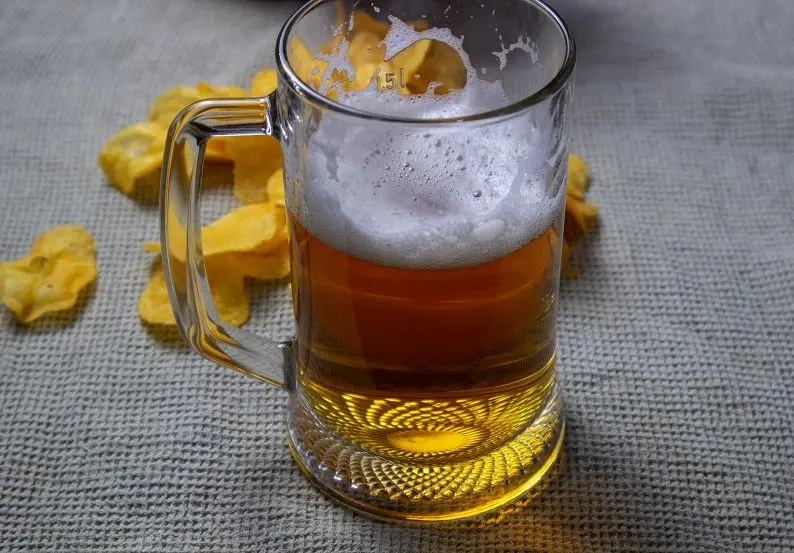
Another method of brewing beer without special equipment is shown in the video.









